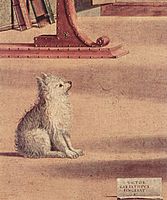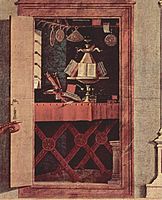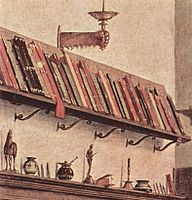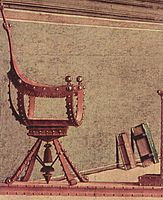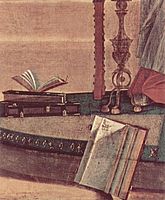User:Clairec10/St. Augustine in His Study (Carpaccio)
St.Augustine in His Study (Carpaccio)[edit]
*Note: my edits will be in Bold, only bold*
| St. Augustine in His Studio | |
|---|---|
 | |
| Artist | Vittore Carpaccio |
| Year | 1502 |
| Medium | Tempera on panel |
| Dimensions | 141 cm × 210 cm (56 in × 83 in) |
| Location | Scuola di San Giorgio degli Schiavoni, Venice |
St. Augustine in His Study (also called Vision of St. Augustine) is an oil and tempera on canvas painting by the Italian Renaissance artist Vittore Carpaccio housed in the Scuola di San Giorgio degli Schiavoni of Venice, northern Italy. The painting depicts St. Augustine while he has a vision, gazing out the window, sitting in a large room filled with objects. The study, or stuliolo, that was a one way that Italian aristocrats and collectors that displayed wealth, power, taste, and worldly knowledge. Carpaccio intentionally opens up the study to the viewer, revealing a vast amount of objects that have different origins and symbolic meanings. The artist signed the work on the small plaque, or cartellino, in the foreground near the dogs that reads: "VICTOR / CARPATHIVS / FINGEBAT" ("Vittore Carpaccio was forming [this]").[1]
Subject and historical misidentification[edit]
This work was painted by Vittore Carpaccio for the Scuola di San Giorgio degli Schiavoni in 1502.[2] Renaissance Venice had many confraternities, religious guilds or corporations, that functioned as charitable organizations.[3] The Scuola di San Giorgio degli Schiavoni was founded in 1451 by a group of Dalmatian immigrants from the region of Dalmatia and known locally as the schiavoni ("Slavs").[2] Their confraternity was dedicated to St. George and St. Tryphon, and later St. Jerome.[4] Vittore Carpaccio was commissioned to create a cycle of nine paintings that illustrate four separate narratives stories about the lives of Christ and Saints Jerome, George, and Tryphon.[2] The majority of scholars agree that the entire cycle of paintings was begun in 1502 and was complete by 1507.[2]
The painting of St. Augustine in his Study is a part of three canvases that narrate important scenes from the life of St.Jerome (c. 342-420 CE), who was born in Stridon, a province of Dalmatia and one of the Catholic Church Fathers.[2]For centuries, the painting was mistakenly thought to be an image of St. Jerome until 1959, when Helen Roberts connected the imagery of the scene to a legend based on a set of three late thirteenth-century apocryphal letters written St Augustine (354-430 CE), who was St. Jerome's younger contemporary.[2] The alleged letter was said to be written by St. Augustine, in which he narrates a moment when he was sitting in a study writing a letter to St. Jerome when he was interrupted with vision.[2] These letters of St. Augustine were inserted into several manuscripts and printed books that were dedicated to the life of St. Jerome and therefore became entwined with his story.[2][5]
The story behind the painting is missing some particular details that may make it more coherent. Some aspects of the painting are left to the viewer's imagination, like the outdoors. The viewer can see that the light shines in through the windows on the right side of the painting, and through the shadows reflected on the ground. But what the viewer cannot see is what exactly is outside, and what exactly St. Augustine is looking at from his luxurious chamber.
Effect on Carpaccio[edit]
This painting was about mid way through Carpaccio's career, the same time he was working with Giovanni Bellini on some major works.
The stylistic choices Carpaccio made reflect his utter focus on detail on the little things to overall make the painting more coherent and add a story to it. The main message Carpaccio pushes being the exuberance and importance of having extraordinary and valuable objects to fit into a certain social category. Having these objects of different cultures and from all over the world reflects not only the literal wealth of St.Augustine but also the wealth of knowledge he has.
Description, imagery, and symbolism[edit]

Style and Perspective[edit]
Carpaccio uses depth in this painting to show the proper distance displayed in St Augustine's room. Carpaccio's punctilious attention to detail of the setting itself compared to the softness and not nearly as detailed figure of St.Augustine himself brings the focus more so on the environment itself. There are so many little things and objects as listed below that show how attentive Carpaccio was to the chambers specifically.
St. Augustine and the vision[edit]
In this image, St. Augustine sits at his desk and writes a letter to St. Jerome, a figure like Augustine, who was also recognized for his intelligence.[7] In the letter, St. Augustine recounts that while he was in his study, in the city of Hippo, he was contemplating treatise on the "glory of blessed souls who rejoice with Christ."[8] He then began to write a letter to St. Jerome about it when he was suddenly bathed in divine light, accompanied by an indescribable aroma.[8] At the very same time, St. Jerome had just died in Bethlehem and then his voice filled the room, chastising St. Augustine about his intellectual pride.[8] Throughout the painting, whether it is the objects or the story behind the painting itself, there is a clear theme of intelligience and the power of knowledge being pushed.
This moment that the painting illustrates St. Augustine's seated at his desk raising his pen, while peering out a window from which miraculous light pours, and which was "not seen in our times, and hardly to be described in our poor language."[8][7] This light is observed in the painting through the long shadows cast shadows across the floor and the mesmerized, attentive expressions of both St. Augustine and his dog, who sits on the floor across the way from him.[8]
A finished preparatory drawing of this painting, made on paper with pen, survives that the British Museum in London that was made around 1501-1508.[9] The detailed drawing that Carpaccio made highlights the setting and the use of light, while the figure of St. Augustine is more sketched.[9] The most striking, albeit a minor difference between the drawing the finished painting, is that the final painting has a dog, where as the drawing shows, as well as the underdrawing of the actual painting (detected using infrared reflectography) was planned as some other small animal, perhaps a cat, weasel or ermine.[8][9]
Moreover, the light illuminates many of the objects that are exhibited throughout St. Augustine's study.[8]
The Study[edit]
St. Augustine is pictured sitting in his Italian stuliolo, or a study that is a private cabinet or room.[10] These studies, also known as kunstkammer, wunderkammer or cabinets of curiosities, were typically used to display collectors items, and became popular in Italy in the fifteenth and sixteenth centuries.[10] Aristocratic families collected items to exhibit their wealth, power, taste, and worldly knowledge, while others such as merchants and humanists collected items to show sophistication and business success.[10] The study is a significant part of the painting's subject, catching the viewer's attention immediately and highlighting St. Augustine as a humanist scholar who was an intelligent, knowledgeable, and pious man.[7] Numerous books lining the bookshelves display St. Augustine's intelligence, as do various objects around the room such as an astrolabe, figurines, a conch shell, furniture, and other ornaments.[7] Other items in the study symbolize St. Augustine's Christian piety, such as the mitre, crook, and statue of the Resurrection of Christ, seen in the small niche with the altar located in the center of the back of the study.[7]
The objects presented were painted based on models and studio props from Islamic, Western, and Italian origin, such as a bronze pacing horse statue, a sculpture of Venus, and the statue of the resurrected Christ.[8] Each one of these objects is distinguished by its own shape, texture, and pop of color in the painting, yet no one object is unequally emphasized.[7]This provides a cataloging effect for these objects, many with symbolic meanings, and reinforces St. Augustine's ownership of them.[7]
Objects in the study[edit]
Many of the objects in the study would usually go unnoticed; however, Vittore Carpaccio chose to display the cabinet in the back left of the painting with the doors wide open and the shelf under the altarpiece with the curtain pulled back in order to allow the viewer to see more in depth into the life of St. Augustine.[10] There is a large number of books on display on a shelf, emphasizing the importance of knowledge to St. Augustine. The door has a lock and key in it to reflect contemporary practices of locking up books since they were considered sacred books.[10] Many other objects are carefully positioned around the study in order to display the collection of St. Augustine.[10] Some of the objects displayed within the paintings were highly sought after and valued in this specific time period. On the left and right walls, there are two lamp holders that resemble some sort of bear or yeti arm. There is something to be said about the diversity of objects within the painting itself. Scholars have argued that the impressive variety of items from the arts, sciences, astronomy, and theology, drawn from different places and historical times, symbolizes the active, intellectual mind of St. Augustine.[8]
Some, but not all the notable objects include the following:
- On and around St. Augustine's desk are found a variety of objects, including: a conch shell, bell, pair of scissors, a Mamluk lidded-vessel made from tin (referred to as "instagnada" in Renaissance inventories), a variety of books (including musical manuscripts at the foot of the desk), and an armillary sphere hangs above the desk.
- The German Spitz is depicted in the bottom left corner of the painting.[8]
- An Italian Renaissance bronze replica of the Horses of San Marco Basilica, situated on the left bookshelf is similar to a statuette of a pacing horse made in Venice in the sixteenth century can be seen at the Ashmolean Museum in Oxford).[8]
- Also on the bookshelf on the far left is an early sixteenth-century bronze version of Venus now at the Victoria and Albert Museum in London)by Pier Jacopo Alari Bonacolsi (known as Antico).[8] The inclusion of the statue of Venus may symbolize the coming of good fortune.[8]
- A Mamluk candlestick, a similar early fourteenth-century one can found at the Metropolitan Museum of Art.[8]
- Three Astrolabe and a quadrant are found in the small room in the left corner of the composition.[8]
- Details
-
In the center of the room is a German Spitz dog
-
A little altar
-
A bookshelf
-
A chair
-
La pedana (platform)
-
Music notes
-
La scrivania (writing desk)
See also[edit]
References[edit]
- ^ Humfrey, Peter (2022). Vittore Carpaccio: Master Storyteller of Renaissance Venice. New Haven: Yale University Press. pp. 170–179. ISBN 9780300254471.
- ^ a b c d e f g h Humfrey, Peter (2022). Vittore Carpaccio: Master Storyteller of Renaissance Venice. New Haven: Yale University Press. pp. 170–179. ISBN 9780300254471.
- ^ Christian, Kathleen; Clark, Leah Ruth (2017). European Art and the Wider World, 1350-1550. Manchester: Manchester University Press. ISBN 978-1-5261-2291-9. OCLC 1200306384.
- ^ "Drawing | British Museum". The British Museum. Retrieved 2023-05-02.
- ^ Roberts, Helen I. (1959). "St. Augustine in "St. Jerome's Study": Carpaccio's Painting and Its Legendary Source". The Art Bulletin. 41 (4): 283–297. doi:10.2307/3047853. ISSN 0004-3079. JSTOR 3047853 – via JSTOR.
- ^ "British Museum Description of Object 1934,1208.1".
- ^ a b c d e f g Lubbock, Tom (17 Sep 2010). "St. Augustine in his Study (c.1502) Vittore Carpaccio Scuola di San Giorgio degli Schiavoni, Venice/The Bridgeman Art Library". The Independent. ProQuest 751065518. Retrieved 2023-03-17 – via Proquest.
- ^ a b c d e f g h i j k l m n o Humfrey, Peter (2022). Vittore Carpaccio: Master Storyteller of Renaissance Venice. New Haven: Yale University Press. pp. 170–179. ISBN 9780300254471.
- ^ a b c "Drawing | British Museum". The British Museum. Retrieved 2023-05-02.
- ^ a b c d e f Christian, Kathleen; Clark, Leah Ruth (2017). European Art and the Wider World, 1350-1550. Manchester: Manchester University Press. ISBN 978-1-5261-2291-9. OCLC 1200306384.
Sources[edit]
- Valcanover, Francesco (2007). "Vittore Carpaccio". Pittori del Rinascimento. Florence: Scala. ISBN 978-88-8117-099-9.

